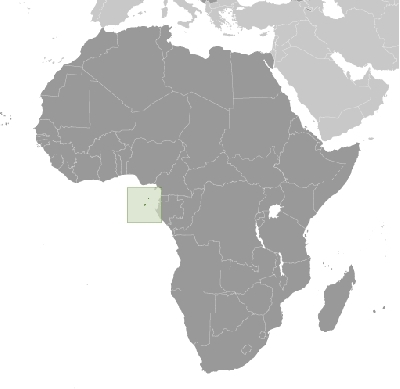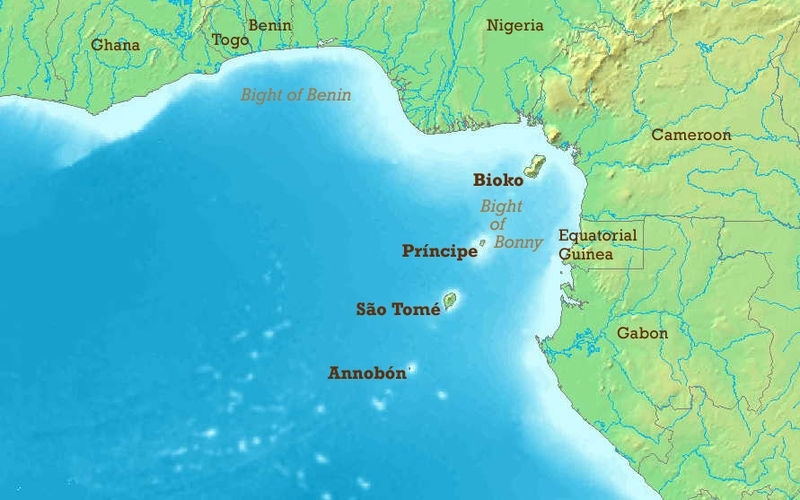São Tomé and Príncipe
Countries and Regions of the World Collection  São Tomé and Príncipe is an African nation of 183,000 people composed of the island of São Tomé and the island of Príncipe which are located in the Gulf of Guinea in the Atlantic Ocean, near the Equator, west of the nation of Gabon.
São Tomé and Príncipe is an African nation of 183,000 people composed of the island of São Tomé and the island of Príncipe which are located in the Gulf of Guinea in the Atlantic Ocean, near the Equator, west of the nation of Gabon.
The islands are part of a chain of volcanic mountains that extend from the mainland into the Gulf of Guinea known as the Cameroon Volcanic Line. Neither island has been volcanically active in modern times.
São Tomé and Príncipe has the second smallest population and area of any African nation (about 183,000 people compared to the Seychelles which has about 87,000).
São Tomé and Príncipe's major environmnetal issues include: deforestation and soil erosion and exhaustion.
Discovered and claimed by Portugal in the late 15th century, the islands' sugar-based economy gave way to coffee and cocoa in the 19th century - all grown with plantation slave labor, a form of which lingered into the 20th century.
While independence was achieved in 1975, democratic reforms were not instituted until the late 1980s.
The country held its first free elections in 1991, but frequent internal wrangling between the various political party's precipitated repeated changes in leadership and two failed coup attempts in 1995 and 2003.
The recent discovery of oil in the Gulf of Guinea promises to attract increased attention to the small island nation.
Contents
Geography
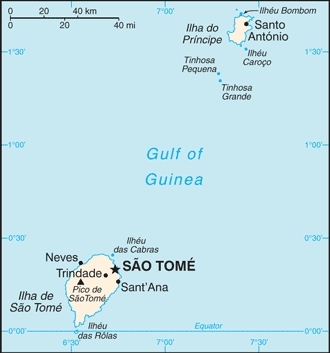 The islands of Sao Tome and Principe are situated in the equatorial Atlantic about 200 miles and 150 miles (320 and 240 kilometers), respectively, off the northwest coast of Gabon. Both are part of an extinct volcanic mountain range that extends to the north where it also includes the island of Bioko off Equatorial Guinea and Mount Cameroon on the Cameroon coast. The island of Sao Tome is 31 miles (50 km) long and 20 miles (32 km) wide and is the more mountainous of the two islands. Its highest peak reaches 6,640 feet (2,024 m). Principe is about 19 miles (30 kilometers) long and 4 miles (6 km) wide. Swift streams run down the mountains through lush forest and cropland to the sea on both islands.
The islands of Sao Tome and Principe are situated in the equatorial Atlantic about 200 miles and 150 miles (320 and 240 kilometers), respectively, off the northwest coast of Gabon. Both are part of an extinct volcanic mountain range that extends to the north where it also includes the island of Bioko off Equatorial Guinea and Mount Cameroon on the Cameroon coast. The island of Sao Tome is 31 miles (50 km) long and 20 miles (32 km) wide and is the more mountainous of the two islands. Its highest peak reaches 6,640 feet (2,024 m). Principe is about 19 miles (30 kilometers) long and 4 miles (6 km) wide. Swift streams run down the mountains through lush forest and cropland to the sea on both islands.
At sea level, the climate is tropical--hot and humid with average yearly temperatures around 80 degrees Fahrenheit (27 degrees Celsius) and little daily variation. At the interior's higher altitudes, the average yearly temperature falls to 68 degrees Fahrenheit (20 degrees Celsius), and nights are generally cooler. Annual rainfall varies from 200 inches (500 centimeters) on the southwestern slopes to 40 inches (100 centimeters) in the northern lowlands. The rainy season runs from October to May.
Location: Western Africa, islands in the Gulf of Guinea, straddling the Equator, west of Gabon
Geographic Coordinates: 1 00 N, 7 00 E
Area: 1,001 km2 (1,001 km2 land and 0 km2 water) 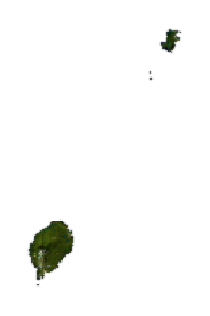 Source: The Map Library
Source: The Map Library
Land Boundaries: 0 km
Coastline: 209 km
Maritime Claims (measured from claimed archipelagic baselines): Territorial sea to 12 nautical miles and an exclusive economic zone to 200 nautical miles.
Natural Hazards: NA
Terrain: Volcanic, Mountainous. Its lowest point is the Atlantic Ocean (0 metres) and its highest point is Pico de Sao Tome (2,024 metres).
The volcanic plugs and mountainous parts of the islands range up to elevations of 948 meters (m) on Príncipe and 2,024 m on São Tomé. An area of low land at the base of the volcanoes is the only relatively flat land on the islands. The volcanic soils of basalts and phonolites, which are more than 3 million years old, are relatively fertile and have been used for plantation crops in the past.
The islands are within the wet tropical belt. On São Tomé, annual rainfall ranges from 1,000 millimeters (mm) in the northeast to more than 4,000 mm in the southwest. Mean annual temperatures range from a maximum of 30° to 33°C to a minimum of 18° to 21°C, with little seasonal variation and high humidity all year. On Príncipe, rainfall patterns are similar; whereas on the island of Annobon rainfall is somewhat less.
Climate: Tropical; hot, humid; one rainy season (October to May)
Ecology and Biodiversity
São Tomé and Príncipe is within the Sao Tome, Príncipe and Annobon moist lowland forests ecoregion. covers the three islands of Príncipe, São Tomé, and Annobon in the Gulf of Guinea, off the west coast of central Africa. The islands support high numbers of endemic species, including several endemic genera and families. Given the islands' small size, they are comparable with other island centers of endemism such as the Galápagos and the Hawaiian archipelagos. Evolutionary features typical of island faunas and floras, such as gigantism, dwarfism, and unusual ecological, physiological, and behavioral adaptations are also found in a range of species. The number of protected areas has been increasing in recent years and forest habitats are regenerating in some places.
During the sixteenth century, a large area of dry forest in the north and northeast of São Tomé was cleared for sugar cane production. After the decline of this cash crop at the end of that century, some of this forest recovered.
From the middle of the nineteenth century, large coffee and cocoa plantations were established on both Príncipe and São Tomé, which led to the widespread modification and destruction of primary rain forest. Rain forest in the north of Príncipe was also severely modified during a campaign against sleeping sickness from 1911-1916. However, many endemic species adapted to the shade forest found in plantations. After the 1930s, and especially following independence in 1975, many plantations were abandoned, and there was some regeneration to secondary forest. Since the mid-1980s, land reforms have led to the development of market gardening and consequent land conversion from coffee and cocoa plantations. Some secondary forest areas have also been cleared once more for agricultural use. This is of some concern because it will put pressure on endemic species that have adapted to secondary and plantation shade forest, and it will also increase pressure on remaining primary forest areas.
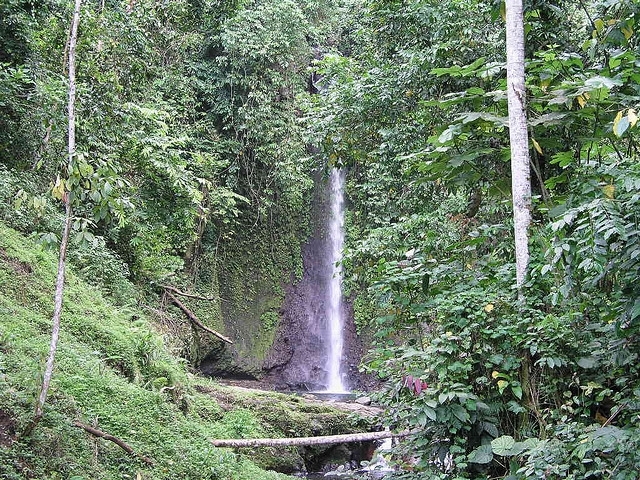
Waterfall near Roça de Bombaim, in the interior of the island of Sao Tomé. Source: Joao Maximo/Flickr
The São Tomé olive pigeon (Columba thomensis, VU), the São Tomé giant sunbird (Nectarinia thomensis, VU), and the giant begonias (Begonia crateris and B. baccata) are all examples of species that have large size compared to similar continental species. The dwarf olive ibis (Bostrychia bocagei, CR) is an example of a species that is much smaller than other members of its genus. Unusual physiological and behavioral adaptations have also occurred such as in the São Tomé weaver (Ploceus sancthithomae), which has become a forest-dwelling tree-creeping species atypical of weavers.
Colonization occurred as species migrated from the African mainland. Thereafter, species have undergone speciation, or have become relictualized as their relatives became extinct on the mainland. Significant radiations exist in a number of groups (e.g. the terrestrial gastropod genus Bocageia and the plant genus Calvoa). There appears to be evidence of older and then more recent colonization of the islands by endemics. Thus the giant sunbird appears to be an older arrival than Newton's yellow-breasted sunbird (Nectarinia newtoni), which more closely resembles its mainland relatives. The taxonomic status of many species remains subject to debate.
These islands have high importance for bird conservation. There are seven endemic bird species on Príncipe. São Tomé possesses a total of sixteen endemic bird species and two endemic genera. A number of endemic subspecies also exist. Some of these would almost certainly be elevated to full species if subjected to further taxonomic study. In a global review of priority areas for bird conservation, Príncipe and São Tomé were both classified as critically important on the basis of the numbers of restricted range bird species occurring together. Four bird species were recently rediscovered after having been unobserved for more than 60 years and are all threatened: the dwarf olive ibis (Bostrychia bocagei, CR), Newton's fiscal (Lanius newtoni, CR), the São Tomé canary (Neospiza concolor, CR), and the São Tomé short-tail (Amaurocichla bocaii, VU). The islands are classified as Endemic Bird Areas.
There is currently estimated to be 40 km2 of primary forest on Príncipe, and 240 km2 on São Tomé. Over larger areas of both islands, secondary forest vegetation is regenerating on old plantations.
Many of the endemic species have adapted to modified habitats on the cocoa and coffee plantations because of the use of shade trees to protect [[crop]s]. Some agencies have proposed to protect the remaining areas of primary forest on São Tomé and Príncipe as national parks. A law establishing procedures for the proclamation and management of a protected area system was passed in 1999. The proposed parks would protect the largest remaining habitat blocks, including areas of primary forest. São Tomé and Príncipe are in the final stages of preparing to declare protected areas to be known as the Parques Naturais d'Ôbo, which will cover a total of 293 km2.
People and Society
Population: 183,176 (July 2012 est.)
Most people live on Sao Tome and less than 10,000 on Principe. All are descended from various ethnic groups that have migrated to the islands since 1485. Six groups are identifiable:
- Mestico, or mixed-blood, descendants of African slaves brought to the islands during the early years of settlement from Benin, Gabon, and Congo and Europeans (these people also are known as filhos da terra or "sons of the land");
- Angolares, reputedly descendants of Angolan slaves who survived a 1540 shipwreck and now earn their livelihood fishing;
- Forros, descendants of freed slaves when slavery was abolished;
- Servicais, contract laborers from Angola, Mozambique, and Cape Verde, living temporarily on the islands;
- Tongas, children of servicais with forros born on the islands; and
- Europeans, primarily Portuguese.
A common Luso-African culture dominates the islands, uniting the groups. Almost everyone belongs to Roman Catholic, Evangelical Protestant, or Seventh-day Adventist Churches, which in turn retain close ties with churches in Portugal.
Ethnic groups: mestico, angolares (descendants of Angolan slaves), forros (descendants of freed slaves), servicais (contract laborers from Angola, Mozambique, and Cape Verde), tongas (children of servicais born on the islands), Europeans (primarily Portuguese)
Age Structure:
0-14 years: 44.7% (male 40,777/female 39,386)
15-64 years: 52.2% (male 46,114/female 47,509)
65 years and over: 3.2% (male 2,634/female 3,086) (2011 est.)
Population Growth Rate: 1.996% (2012 est.)
Birth Rate: 37.02 births/1,000 population (2012 est.)
Death Rate: 7.93 deaths/1,000 population (July 2012 est.)
Net Migration Rate: -9.14 migrant(s)/1,000 population (2012 est.)
Life Expectancy at Birth: 63.49 years
male: 62.27 years
female: 64.74 years (2012 est.)
Total Fertility Rate: 4.94 children born/woman (2012 est.)
Languages: Portuguese (official)
Literacy (2001 census): 84.9% (male: 92.2% - female: 77.9%)
Urbanization: 62% of total population (2010) growing at a 2.8% annual rate of change (2010-15 est.)
History
Portuguese navigators first discovered the uninhabited islands between 1469 and 1472. The first successful settlement on Sao Tome was established in 1493 by Alvaro Caminha, who had received the land as a grant from the Portuguese crown. Seven years later in 1500, Principe was settled under a similar arrangement. These grants ended when the Portuguese crown fully took over Sao Tome in 1522 and Principe in 1573. By mid-century, less than 100 years after discovering it, the Portuguese had turned the islands into Africa's foremost exporter of sugar with the help of slave labor from the African coast. However, sugar cultivation declined over the next 100 years, and by the mid-1600s, Sao Tome was little more than a port of call to refuel ships.
This situation lasted for roughly 150 years until in the early 1800s when two new cash crops, coffee and cocoa, were introduced. The rich volcanic soils proved well suited to the new cash crop industry. By 1908, Sao Tome had become the world's largest producer of cocoa. Extensive plantations (rocas), owned by Portuguese companies or absentee landlords, cultivated most of the good farmland.
The rocas system, which gave the plantation managers a high degree of authority, led to abuses against the African farm workers. Although Portugal officially abolished slavery in 1876, the practice of forced paid labor continued. In the early 1900s, an internationally publicized controversy arose over charges that Angolan contract workers were being subjected to forced labor and unsatisfactory working conditions. Sporadic labor unrest and dissatisfaction continued until they culminated in an outbreak of riots in 1953 in which several hundred African laborers were killed in a clash with the Portuguese. This "Batepa Massacre" remains a major event in the colonial history of the islands, and the government officially observes its anniversary on February 3. Although the Portuguese crushed the riots, an independence movement emerged in the aftermath.
By the late 1950s, a small group of Sao Tomeans formed the Movement for the Liberation of Sao Tome and Principe (MLSTP). Unable to remain on the islands, they eventually established a base in nearby Gabon. Although the independence movement grew stronger in the 1960s, events accelerated rapidly after the overthrow of the Salazar and Caetano dictatorship in Portugal in April 1974. The new Portuguese regime was committed to the dissolution of its overseas colonies and in November 1974, their representatives met with the MLSTP in Algiers. There, the two sides worked out an agreement for the transfer of sovereignty. The movement toward independence precipitated an exodus of most of the 4,000 Portuguese residents in the 1970s. After a period of transitional government, Sao Tome and Principe achieved independence on July 12, 1975, and chose as its first president the MLSTP Secretary General, Manuel Pinto da Costa. He established a one-party state and served as president until 1990.
In 1990, Sao Tome became one of the first African states to embrace democratic reform. Changes to the constitution, including the legalization of opposition political parties, led to nonviolent, free, and transparent elections in 1991. Miguel Trovoada, the country’s first Prime Minister who had been in exile since 1986, returned as an independent candidate and was elected president. The Party of Democratic Convergence (PCD) beat the MLSTP to take a majority of seats in the National Assembly, with the MLSTP becoming an important and vocal minority party. Municipal elections followed in late 1992 in which the MLSTP came back to win a majority of seats on five of seven regional councils. The MLSTP followed this victory by winning a plurality of seats in the Assembly in early legislative elections held in October 1994. It regained an outright majority of seats in the November 1998 elections. Meanwhile, Trovoada formed his own party, the Independent Democratic Action Party (ADI), and was re-elected president in the second multiparty presidential election in 1996.
The next presidential elections were held in July 2001. The candidate backed by the ADI, Fradique de Menezes, was elected in the first round. Parliamentary elections held in March 2002 led to a coalition government after no party gained a majority of seats. An attempted coup d'etat in July 2003 by a few members of the military and the Christian Democratic Front (mostly representative of former Sao Tomean volunteers from the apartheid-era Republic of South African Army) was reversed by international mediation without bloodshed. In September 2004, President Menezes dismissed the Prime Minister and appointed a new cabinet, a move which was accepted by the majority party. In June 2005, following public discontent with oil exploration licenses granted in the Joint Development Zone (JDZ) with Nigeria, the MLSTP, the majority party, and its coalition partners threatened to resign from government and force early parliamentary elections. After several days of negotiations, the President and the MLSTP agreed to form a new government and thus avoid early elections.
The March 2006 legislative elections were held without problems. President Menezes' party, the Movement for the Democratic Force of Change (MDFM), in coalition with PCD, won 23 seats and took an unexpected lead ahead of the MLSTP. The MLSTP came in second with 20 seats, the ADI came in third with 11 seats, and the movement “Novo Rumo” gained one seat.
Sao Tome and Principe held its fourth democratic, multiparty presidential elections on July 30, 2006. Local and international observers described the elections as being free and fair. Incumbent President Menezes won the election with approximately 60% of the vote. Voter turnout was relatively high with 63% of the 91,000 registered voters casting ballots.
In November 2007 Prime Minister Tome Vera Cruz threatened to resign, and several ministers in his government were replaced following significant public criticism of souring economic conditions and the government's handling of recurring mutinies by dissident police officers. The changes took place peacefully and without incident. During another government shakeup in February 2008, President Menezes appointed Patrice Trovoada as prime minister.
On May 20, 2008 the government collapsed after losing a parliamentary vote of confidence. The opposition Movement for the Liberation of Sao Tome and Principe-Social Democratic Party (MLSTP-PSD), with the support of PCD, asserted that Prime Minister Trovoada had failed to deliver on reforms that he promised when he entered office. Joaquim Rafael Branco became Prime Minister in June 2008.
On December 19, 2009 President Menezes was elected to lead the MDFM party. His election was challenged both within the party and by constitutional experts as unconstitutional. Constitutionalists argued that according to the country’s semi-presidential constitution, the president could not exercise any other public or private function, including the post of party leader. The two coalition partners of the MDFM, MLSTP-PSD and PCD, criticized the election and announced an appeal to the constitutional court.
In response to the MLSTP appeal, Menezes withdrew the three MDFM ministers from the coalition (Menezes directly controlled those particular ministers). However, two of the ministers, Justino Veiga and Cristina Dias, declared that they would continue in the government. This was impeded by Menezes, who vetoed Prime Minister Branco’s (MLSTP) intention to keep the two ministers in a reshuffled cabinet. Unexpectedly, 2 days later, Menezes resigned the MDFM leadership, but denied that his decision had been influenced by any outside pressures.
Legislative elections were held on August 1, 2010, and were deemed free and fair by international observers. Patrice Trovoada's ADI party won 26 of the 55 National Assembly seats, just two seats shy of a majority. The MLSTP-PSD party won 21 seats, the PCD 7, and President Menezes' MDFM party only one seat. A new government was formed on August 14, with Trovoada again appointed Prime Minister. On July 17, 2011 the country's fifth democratic and multiparty presidential elections were held, with a runoff on August 7, 2011. Former president Manuel Pinto da Costa was elected in a narrow victory over the Speaker of Parliament, Evaristo Carvalho. Incumbent President Menezes, having served two terms, was constitutionally precluded from seeking a third term. President da Costa took office in September 2011.
Government
Government Type: Republic
Following the promulgation of a new constitution in 1990, Sao Tome and Principe held multiparty elections for the first time since independence. Shortly after the constitution took effect, the National Assembly formally legalized opposition parties. Independent candidates also were permitted to participate. The 55-member National Assembly is the supreme organ of the state and the highest legislative body. Its members are elected for a 4-year term and meet semiannually.
Capital: Sao Tome - 60,000 (2009)
Administrative Divisions: Administratively, the country is divided into six municipal districts, five on Sao Tome and one comprising Principe. Governing councils in each district maintain a limited number of autonomous decision-making powers and are reelected every 3 years.
Independence Date: 12 July 1975 (from Portugal)
Legal System: based on Portuguese legal system and customary law; has not accepted compulsory ICJ jurisdiction.
The president of the republic is elected to a 5-year term through direct universal suffrage and a secret ballot and may hold office up to two consecutive terms. Candidates are chosen at their party's national conference or individuals may run independently. A presidential candidate must obtain an outright majority of the popular vote in either a first or second round of voting in order to be elected president. The party that wins a majority in the legislature names the prime minister, who must be approved by the president. The prime minister, in turn, names the members of the cabinet.
The Supreme Court administers justice at the highest level. The judiciary is independent under the current constitution.
Suffrage: 18 years of age; universal
International Environmental Agreements
São Tomé and Príncipe is party to international agreements on: Biodiversity, Climate Change, Desertification, Endangered Species, Environmental Modification, Law of the Sea, Ozone Layer Protection, Ship Pollution, and Wetlands.
Agriculture
Agricultural Products: cocoa, coconuts, palm kernels, copra, cinnamon, pepper, coffee, bananas, papayas, beans; poultry; fish
Land Use: 100 sq km (2003)
Resources
Natural Resources: fish, hydropower.
Land Use:
arable land: 8.33%
permanent crops: 48.96%
other: 42.71% (2005)
Energy
| Energy in Sao Tome and Principe | |||||
| Production | Consumption | Exports | Imports | Reserves | |
| Electricity | 41 million kWh (2008 est.) |
38.13 million kWh (2008 est.) |
0 kWh (2009) |
0 kWh (2009 est.) |
|
| Oil | 0 bbl/day (2010 est.) |
1,000 bbl/day (2010 est.) |
0 bbl/day (2009 est.) |
889 bbl/day (2009 est.) |
0 bbl (1 January 2010 est.) |
| Natural Gas | 0 cu m (2009 est.) |
0 cu m (2009 est.) |
0 cu m (2009 est.) |
0 cu m (2009 est.) |
0 cu m (1 January 2010 est.) |
| Source: CIA Factbook | |||||
Economy
Since the 1800s, plantation agriculture has dominated the economy of Sao Tome and Principe. At the time of independence, Portuguese-owned plantations occupied 90% of the cultivated area. After independence, control of these plantations passed to various state-owned agricultural enterprises, which have since been privatized. The dominant crop on Sao Tome is cocoa, representing about 95% of exports. Cocoa production has substantially declined in recent years because of drought and mismanagement. Other export crops include copra (a coconut product), palm kernels, and coffee.
With export crops the focus of agricultural production, domestic food-crops are inadequate to meet local consumption, resulting in the need for food imports. Foreign donors are financing projects to expand food production, which now includes bananas, beans, cinnamon, and pepper. Cultivated land amounts to 484 sq. kilometers of the country’s roughly 1,000 sq. kilometers, even though agriculture accounted for only 14% of GDP in 2009.
Other than agriculture, the main economic activities center on fishing and a small industrial sector engaged in light construction, processing local agricultural products, and producing a few basic consumer goods such as clothing, soap, beer, and palm oil. The scenic islands have potential for tourism, and the government is attempting to improve its rudimentary tourist industry infrastructure. The government sector accounts for about 11% of employment.
Following independence, the country had a centrally directed economy with most means of production owned and controlled by the state. The original constitution guaranteed a 'mixed economy' with privately owned cooperatives combined with publicly owned property and means of production. However, in the 1980s and 1990s, the economy of Sao Tome encountered major difficulties. Efforts to redistribute plantation land resulted in decreased cocoa production while at the same time the international price of cocoa slumped. Economic growth stagnated, and cocoa exports dropped in both value and volume creating large balance-of-payments deficits.
In response to the economic downturn, the government undertook a series of far-reaching economic reforms. In 1987, the government implemented an International Monetary Fund (IMF) structural adjustment program and invited greater private participation in management of the state corporations (parastatals), as well as in the agricultural, commercial, banking, and tourism sectors. The focus of economic reform since the early 1990s has been widespread privatization, especially of the state-run agricultural and industrial sectors.
The Sao Tomean Government has traditionally relied on foreign assistance from various donors, including the UN Development Program (UNDP), the World Bank, the European Union (EU), Portugal, Taiwan, and the African Development Bank (AFDB). Sao Tome qualified for debt relief when it reached decision point under the IMF's Heavily Indebted Poor Countries Initiative (HIPC) in December 2000, but it went off track on its poverty reduction program in early 2001. After 4 years and satisfactory performance on an interim staff-monitored program, the IMF approved a 3-year $4.3 million Poverty Reduction and Growth Facility (PRGF) program for Sao Tome in September 2005. The ambitious program aimed to reduce inflation to a single-digit number, address the country's macroeconomic imbalances, and substantially reduce poverty. Another 3-year PRGF arrangement was approved in March 2009.
In 2001, Sao Tome and Nigeria reached agreement on joint exploration for petroleum in waters claimed by the two countries. After a lengthy series of negotiations, in April 2003 the joint development zone (JDZ) was opened for bids by international oil firms. The JDZ was divided into 9 blocks; the winning bids for block one, Chevron, ExxonMobil, and the Norwegian firm Equity Energy, were announced in April 2004, with Sao Tome to take in 40% of the $123 million bid, and Nigeria the other 60%. Blocks 2 through 6 were allocated in June 2005. Nigeria and Sao Tome signed production sharing contracts with the winning bidders in November 2005. Chevron became the first firm to start exploratory drilling in January 2006.
Portugal remains one of Sao Tome's major trading partners, particularly as a source of imports. Food, manufactured articles, machinery, and transportation equipment are imported primarily from the European Union via Portugal. Sao Tome and Principe has to import fuels, most manufactured goods, consumer goods, and a substantial amount of food, making it vulnerable to fluctuations in global commodity prices.
In August 2005, the government signed on to a new 3-year IMF Poverty Reduction and Growth Facility (PRGF) program worth $4.3 million. In April 2011 the country completed a Threshold Country Program with The Millennium Challenge Corporation to help increase tax revenues, reform customs, and improve the business environment. Considerable potential exists for development of a tourist industry, and the government has taken steps to expand facilities in recent years.
The government also has attempted to reduce price controls and subsidies.
Maintaining control of inflation, fiscal discipline, and increasing flows of foreign direct investment into the oil sector, are the major economic problems facing the country.
GDP (Purchasing Power Parity): $306 million (2011 est.)
GDP (Official Exchange Rate): $200 million (2011 est.)
GDP- per capita (PPP): $2,000 (2011 est.)
GDP- composition by sector:
agriculture: 14.6%
industry: 23.8%
services: 61.7% (2011 est.)
Population Below Poverty Line: 54% (2004 est.)
Industries: light construction, textiles, soap, beer, fish processing, timber
Exports: cocoa 80%, copra, coffee, palm oil
Export Partners: Belgium 24.3%, Netherlands 24.3%, France 13.2%, [[]US]] 6%, Portugal 4.3% (2006)
Imports: machinery and electrical equipment, food products, petroleum products
Import Partners: Portugal 60.9%, US 11.3%, Gabon 4.4% (2006)
Economic Aid Recipient: $31.9 million in December 2000 under the Heavily Indebted Poor Country Initiative (HIPC) program (2005)
Currency: dobra (STD)
Ports and Terminals: Sao Tome

